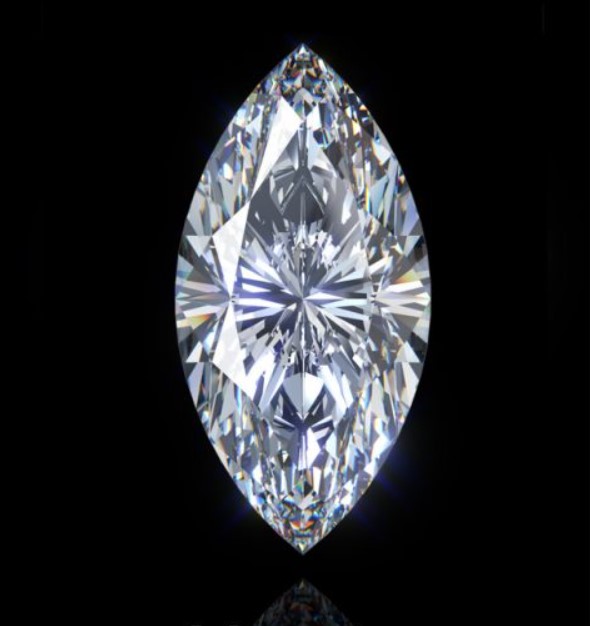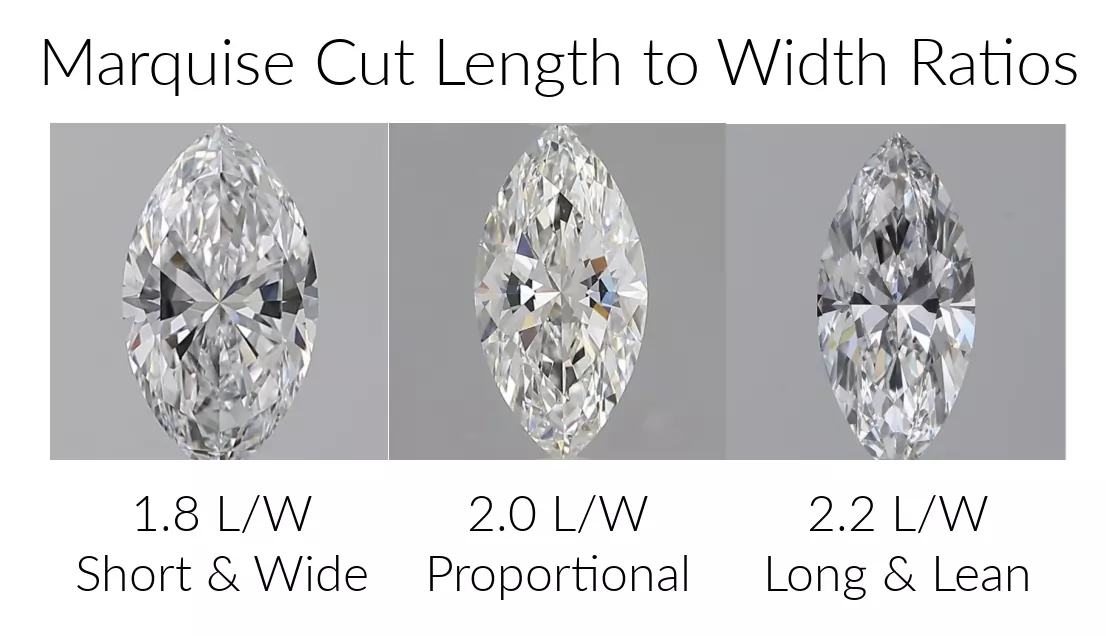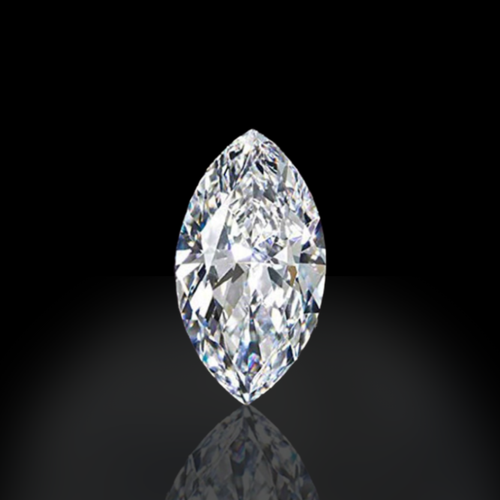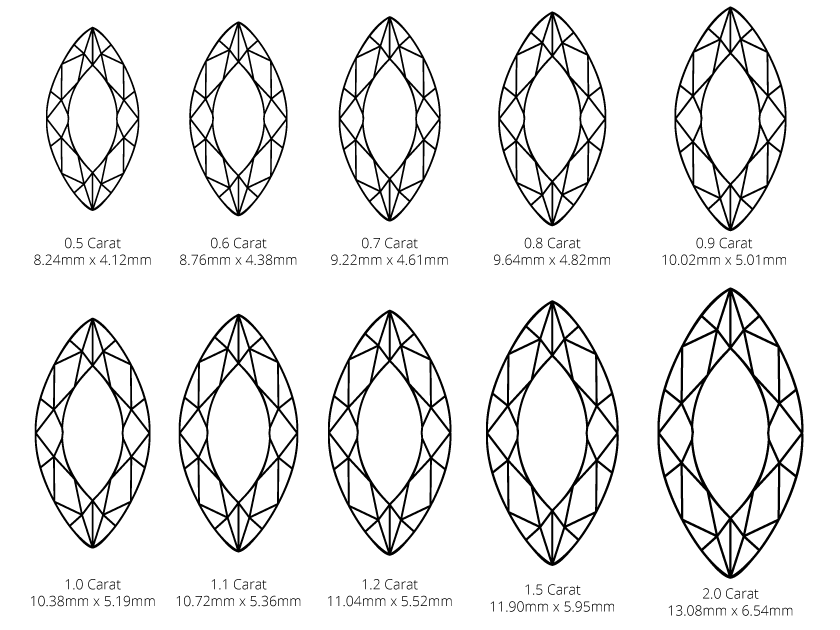Marquise Cut Diamond
Marquise Cut Diamond

Key Takeaways:
- Marquise cut diamonds are among the most popular diamond shapes. There come times when they are the go-to choice, and so too times when marquise cuts are the least popular.
- When buying marquise cut diamonds, make sure that you know the length-to-width ratio that you prefer (see the image above for comparison). We recommend a range between 1.8-2.05.
- In terms of cut, consider a marquise cut with a total depth of 56%-64%, a table of 52%-63%, and a tolerance of 1-2% (up or down).
- In terms of clarity, SI1 is often eye clean in under 1.5 carat stones, while VS2 is also a good grade for the 2-2.5 carat range. If you are on a budget, a good SI2 might also work in the under 1 carat range.
- In terms of color, D-F colors are great options, though we recommend G color. H and I are also great budget options.
- We recommend that you consider either a GIA or AGS graded marquise cut diamond.
- Ensure that you have sufficient knowledge about fluorescence and how it affects the price of a diamond.

Marquise Cut Overview:
The marquise cut diamond is a modified brilliant-cut that features an elongated and pointed end and a football/curved shape. It adopted its name from Marquise of Pompadour during the 18th century, for whom King Louis XIV of France asked for a stone that could perfectly resemble the shape of her mouth. The marquise cut diamond is also known as the “Navette” cut and has features like the oval cut diamonds. Its long and narrow shape creates an illusion of greater size than other shapes of the same carat weight.
Consider the marquise cut diamond if you wish that your diamond stands out in the crowd. Its inimitable and explicit shape would demand attention, especially when placed in a solitaire setting. Marquise cut diamonds have the largest crown surface areas among the diamond shapes—another reason for their perceived greater size.
Here are a few things to remember when buying marquise cut diamonds: marquise cut diamonds’ long and narrow edges will most likely bleak or chip if the bow-tie effect is left unconsidered. Watch for sharp edges and pointed ends in a marquise cut diamond and ensure that the angles of the diamond are properly cut.
Analyzing Marquise Cut:
|
Depth %
|
Table %
|
|
Culet
|
Girdle
|
|
Length to Width Ratio
|
Crown Height %
|
The chart above serves as a general guideline when evaluating the cut of a marquise diamond. The length to width ratio of 1.74-2.25 is considered the classic cut for a marquise diamond, although personal preference could override it. When buying a marquise cut diamond, pay due attention to the symmetry. The right and left sides should form a near mirror image, and the two ends should align perfectly to each other. A slight misalignment would ruin the beauty of the diamond, which is why we recommend an excellent to very good symmetry in a marquise cut diamond.
The setting for a marquise cut diamond should have prongs to protect the endpoints of the diamond. The prongs will play a key role in hiding the flaws, such as naturals, extra facets, and other inclusions often found near the outer edge of a rough stone.

Evaluating Color:
Like evaluating the color in other diamond shapes, color in a marquise cut diamond is critical. The higher the color grade, the better. In our experience, many buyers prefer the warmer colors over the colorless ones given the price difference. In the color spectrum, the former (warmer colors) refer to the near colorless range of G-I color diamonds while the later (colorless colors) refer to D-F color diamonds. The price premium for a lower color grade marquise cut diamond would be significantly lower. Any marquise cut diamond with a carat size over 1.0 will probably include colors that appear slightly darker at the endpoints. Therefore, you must consider choosing one color grade higher than you would usually buy.
For more detailed information on the color of cushion cut diamond, use the table below.
|
< 0.50 Carat
|
0.51 – 1.0 Carat
|
|
1.0 – 2.0 Carat
|
>2.0 Carat
|
Choosing Clarity:
Choose a marquise cut diamond that meets your standards in terms of clarity. Each of our customers has a unique standard for clarity and color. Some want a flawless diamond, while others are perfectly comfortable with a slight inclusion if not easily noticeable. The GIA provides excellent help with their clarity grades, enabling you to choose a marquise cut diamond reflective of your standards.
|
< 0.50 Carat
|
0.51 – 1.0 Carat
|
|
1.0 – 2.0 Carat
|
>2.0 Carat
|

Suggested carat weight, cut, color and clarity of Marquise Cut Diamond for people with budget constraints:
Excellent Choice
- At least 1.0 carats in Weight
- Very Good to Excellent Polish and Symmetry
- G or above in Color
- SI1 or above in clarity
- No Fluorescence
- Length/width ratios: 1.74 – 2.02
Very Good Choice
- At least 0.90 carats in Weight
- Good to Excellent Polish and Symmetry
- H or above in Color
- SI1 or above in Clarity
- None, faint or medium blue fluorescence
- Length/width ratios: 1.74 – 2.02
Good Choice
- At least 0.80 Carats in Weight
- Good to Very Good Polish and Symmetry
- I or above in Color
- SI1 or above in Clarity
- None, faint or medium blue fluorescence
- Length/width ratios: 1.74 – 2.02
Credit: Sharif Khan on 11th Jan 2021
